Australian Health Workforce Planning and International Migration
VerifiedAdded on 2023/04/08
|16
|2512
|340
Report
AI Summary
This report provides a comprehensive analysis of health workforce planning in Australia, focusing on the impact of international migration. It examines the Australian government's strategies, including the Health Workforce Australia (HWA), skilled migration policies, and the Modified Occupation Demand List (MODL). The report presents data on the proportion of the clinical health workforce, including medical practitioners, nurses, and midwives, who have initial qualifications from overseas countries. It also explores the challenges faced by the Australian health workforce, such as self-sufficiency, demographic shifts, and cost barriers. The report discusses the strategies developed by the Australian government to address these challenges, including temporary and permanent skilled migration programs. Main findings highlight the supply and resource-driven approach to health workforce planning in Australia and the cycles of oversupply and shortages. The report concludes with recommendations for improving health workforce planning and addressing the negative effects of health worker migration, emphasizing the need for strategies to retain, recruit, and support health professionals trained overseas. The report also presents data on the number of ENs and RNs, Registered midwives, and medical practitioners in Australia from 2011 to 2015. The report also presents data on the number of permanent and temporary skilled medical personnel in Australia from 2008-09 to 2015-16 and trends in health practitioner migrating from various countries to Australia.
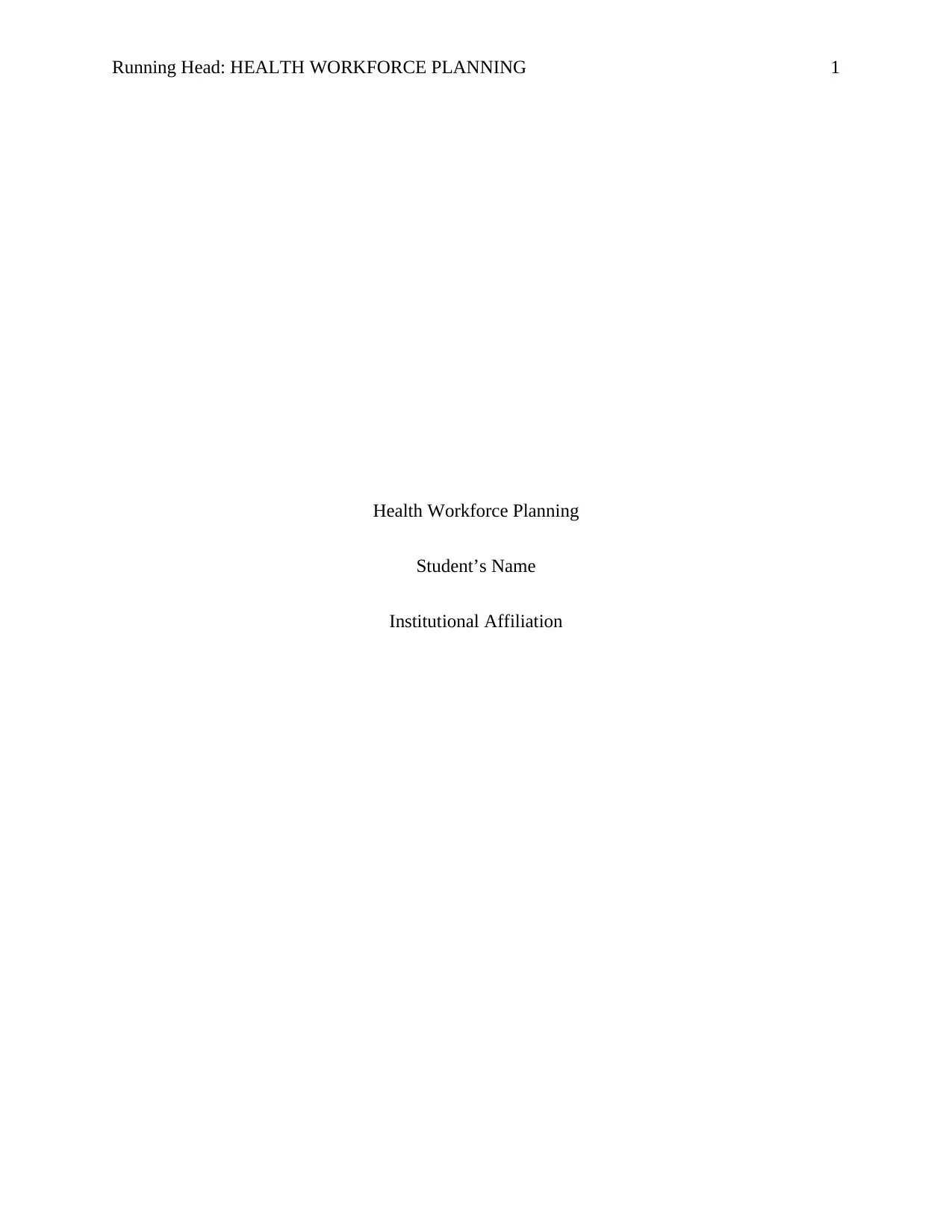
Running Head: HEALTH WORKFORCE PLANNING 1
Health Workforce Planning
Student’s Name
Institutional Affiliation
Health Workforce Planning
Student’s Name
Institutional Affiliation
Paraphrase This Document
Need a fresh take? Get an instant paraphrase of this document with our AI Paraphraser
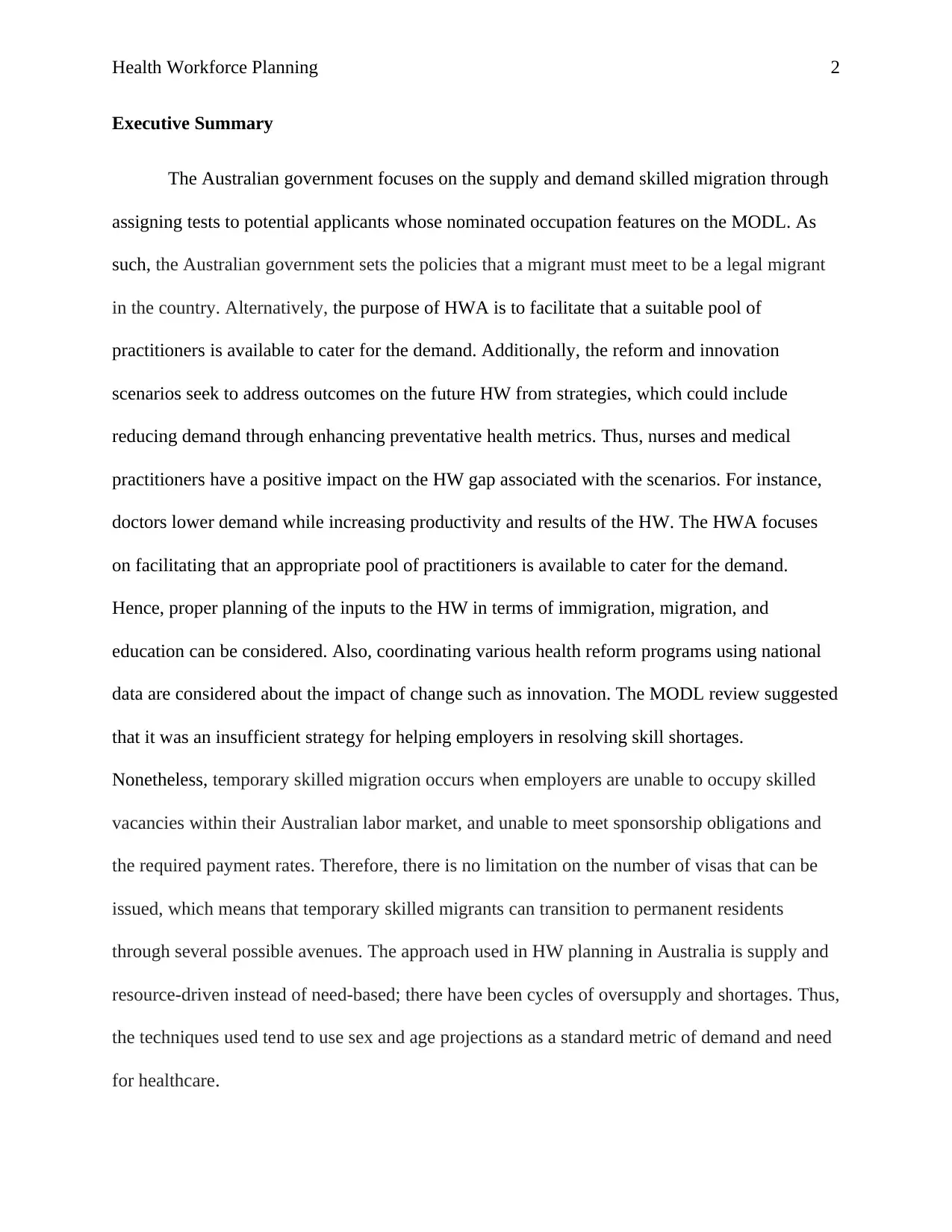
Health Workforce Planning 2
Executive Summary
The Australian government focuses on the supply and demand skilled migration through
assigning tests to potential applicants whose nominated occupation features on the MODL. As
such, the Australian government sets the policies that a migrant must meet to be a legal migrant
in the country. Alternatively, the purpose of HWA is to facilitate that a suitable pool of
practitioners is available to cater for the demand. Additionally, the reform and innovation
scenarios seek to address outcomes on the future HW from strategies, which could include
reducing demand through enhancing preventative health metrics. Thus, nurses and medical
practitioners have a positive impact on the HW gap associated with the scenarios. For instance,
doctors lower demand while increasing productivity and results of the HW. The HWA focuses
on facilitating that an appropriate pool of practitioners is available to cater for the demand.
Hence, proper planning of the inputs to the HW in terms of immigration, migration, and
education can be considered. Also, coordinating various health reform programs using national
data are considered about the impact of change such as innovation. The MODL review suggested
that it was an insufficient strategy for helping employers in resolving skill shortages.
Nonetheless, temporary skilled migration occurs when employers are unable to occupy skilled
vacancies within their Australian labor market, and unable to meet sponsorship obligations and
the required payment rates. Therefore, there is no limitation on the number of visas that can be
issued, which means that temporary skilled migrants can transition to permanent residents
through several possible avenues. The approach used in HW planning in Australia is supply and
resource-driven instead of need-based; there have been cycles of oversupply and shortages. Thus,
the techniques used tend to use sex and age projections as a standard metric of demand and need
for healthcare.
Executive Summary
The Australian government focuses on the supply and demand skilled migration through
assigning tests to potential applicants whose nominated occupation features on the MODL. As
such, the Australian government sets the policies that a migrant must meet to be a legal migrant
in the country. Alternatively, the purpose of HWA is to facilitate that a suitable pool of
practitioners is available to cater for the demand. Additionally, the reform and innovation
scenarios seek to address outcomes on the future HW from strategies, which could include
reducing demand through enhancing preventative health metrics. Thus, nurses and medical
practitioners have a positive impact on the HW gap associated with the scenarios. For instance,
doctors lower demand while increasing productivity and results of the HW. The HWA focuses
on facilitating that an appropriate pool of practitioners is available to cater for the demand.
Hence, proper planning of the inputs to the HW in terms of immigration, migration, and
education can be considered. Also, coordinating various health reform programs using national
data are considered about the impact of change such as innovation. The MODL review suggested
that it was an insufficient strategy for helping employers in resolving skill shortages.
Nonetheless, temporary skilled migration occurs when employers are unable to occupy skilled
vacancies within their Australian labor market, and unable to meet sponsorship obligations and
the required payment rates. Therefore, there is no limitation on the number of visas that can be
issued, which means that temporary skilled migrants can transition to permanent residents
through several possible avenues. The approach used in HW planning in Australia is supply and
resource-driven instead of need-based; there have been cycles of oversupply and shortages. Thus,
the techniques used tend to use sex and age projections as a standard metric of demand and need
for healthcare.
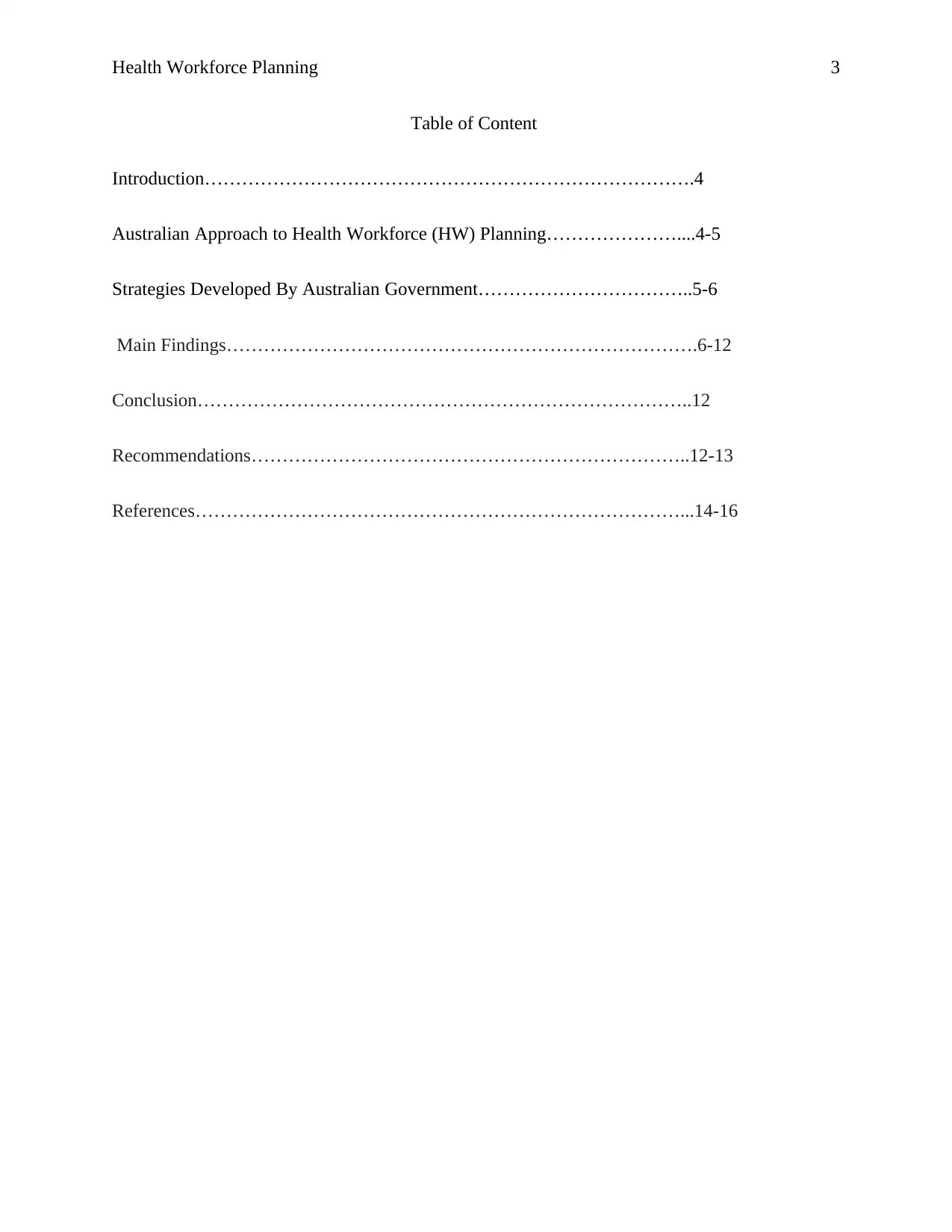
Health Workforce Planning 3
Table of Content
Introduction…………………………………………………………………….4
Australian Approach to Health Workforce (HW) Planning…………………....4-5
Strategies Developed By Australian Government……………………………..5-6
Main Findings………………………………………………………………….6-12
Conclusion……………………………………………………………………..12
Recommendations……………………………………………………………..12-13
References……………………………………………………………………...14-16
Table of Content
Introduction…………………………………………………………………….4
Australian Approach to Health Workforce (HW) Planning…………………....4-5
Strategies Developed By Australian Government……………………………..5-6
Main Findings………………………………………………………………….6-12
Conclusion……………………………………………………………………..12
Recommendations……………………………………………………………..12-13
References……………………………………………………………………...14-16
⊘ This is a preview!⊘
Do you want full access?
Subscribe today to unlock all pages.

Trusted by 1+ million students worldwide
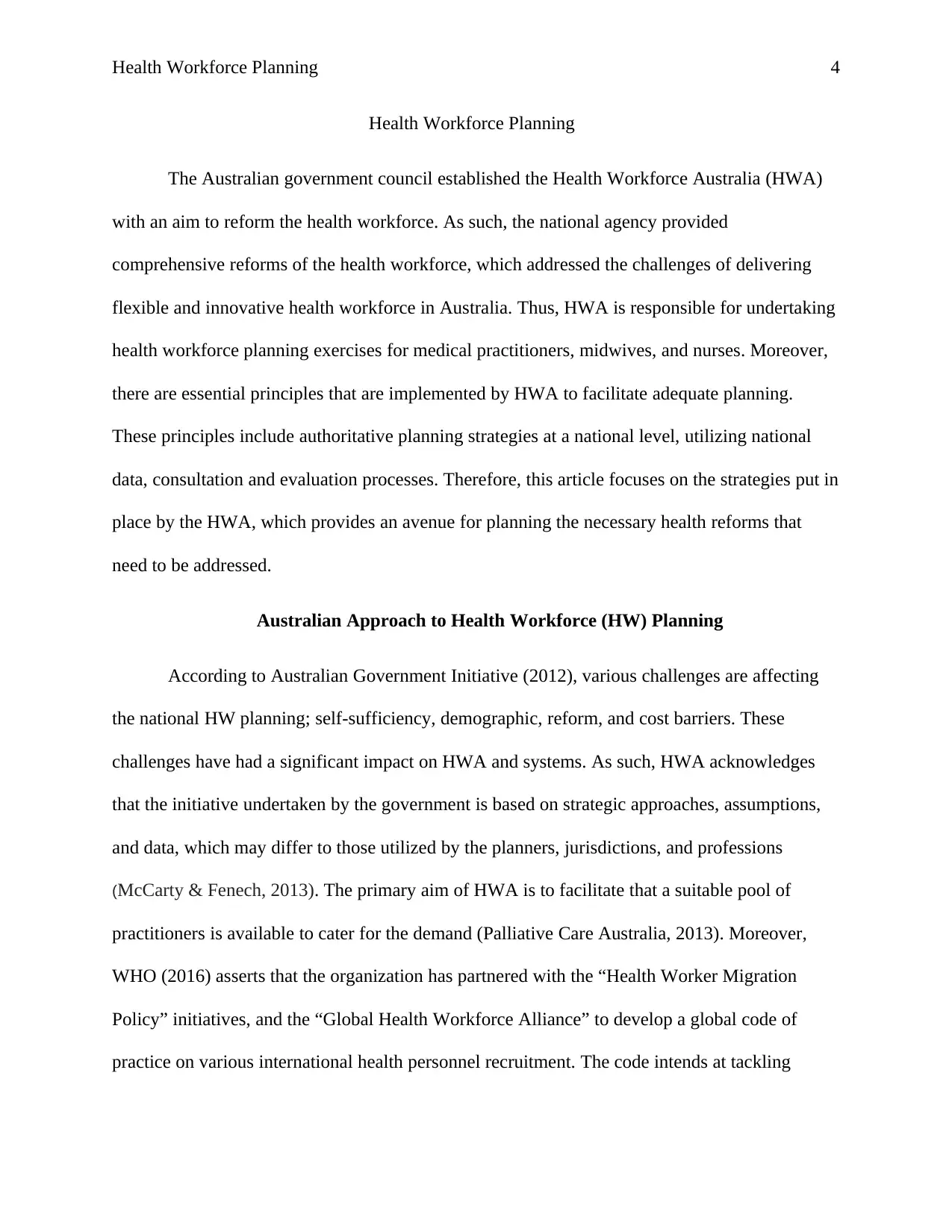
Health Workforce Planning 4
Health Workforce Planning
The Australian government council established the Health Workforce Australia (HWA)
with an aim to reform the health workforce. As such, the national agency provided
comprehensive reforms of the health workforce, which addressed the challenges of delivering
flexible and innovative health workforce in Australia. Thus, HWA is responsible for undertaking
health workforce planning exercises for medical practitioners, midwives, and nurses. Moreover,
there are essential principles that are implemented by HWA to facilitate adequate planning.
These principles include authoritative planning strategies at a national level, utilizing national
data, consultation and evaluation processes. Therefore, this article focuses on the strategies put in
place by the HWA, which provides an avenue for planning the necessary health reforms that
need to be addressed.
Australian Approach to Health Workforce (HW) Planning
According to Australian Government Initiative (2012), various challenges are affecting
the national HW planning; self-sufficiency, demographic, reform, and cost barriers. These
challenges have had a significant impact on HWA and systems. As such, HWA acknowledges
that the initiative undertaken by the government is based on strategic approaches, assumptions,
and data, which may differ to those utilized by the planners, jurisdictions, and professions
(McCarty & Fenech, 2013). The primary aim of HWA is to facilitate that a suitable pool of
practitioners is available to cater for the demand (Palliative Care Australia, 2013). Moreover,
WHO (2016) asserts that the organization has partnered with the “Health Worker Migration
Policy” initiatives, and the “Global Health Workforce Alliance” to develop a global code of
practice on various international health personnel recruitment. The code intends at tackling
Health Workforce Planning
The Australian government council established the Health Workforce Australia (HWA)
with an aim to reform the health workforce. As such, the national agency provided
comprehensive reforms of the health workforce, which addressed the challenges of delivering
flexible and innovative health workforce in Australia. Thus, HWA is responsible for undertaking
health workforce planning exercises for medical practitioners, midwives, and nurses. Moreover,
there are essential principles that are implemented by HWA to facilitate adequate planning.
These principles include authoritative planning strategies at a national level, utilizing national
data, consultation and evaluation processes. Therefore, this article focuses on the strategies put in
place by the HWA, which provides an avenue for planning the necessary health reforms that
need to be addressed.
Australian Approach to Health Workforce (HW) Planning
According to Australian Government Initiative (2012), various challenges are affecting
the national HW planning; self-sufficiency, demographic, reform, and cost barriers. These
challenges have had a significant impact on HWA and systems. As such, HWA acknowledges
that the initiative undertaken by the government is based on strategic approaches, assumptions,
and data, which may differ to those utilized by the planners, jurisdictions, and professions
(McCarty & Fenech, 2013). The primary aim of HWA is to facilitate that a suitable pool of
practitioners is available to cater for the demand (Palliative Care Australia, 2013). Moreover,
WHO (2016) asserts that the organization has partnered with the “Health Worker Migration
Policy” initiatives, and the “Global Health Workforce Alliance” to develop a global code of
practice on various international health personnel recruitment. The code intends at tackling
Paraphrase This Document
Need a fresh take? Get an instant paraphrase of this document with our AI Paraphraser
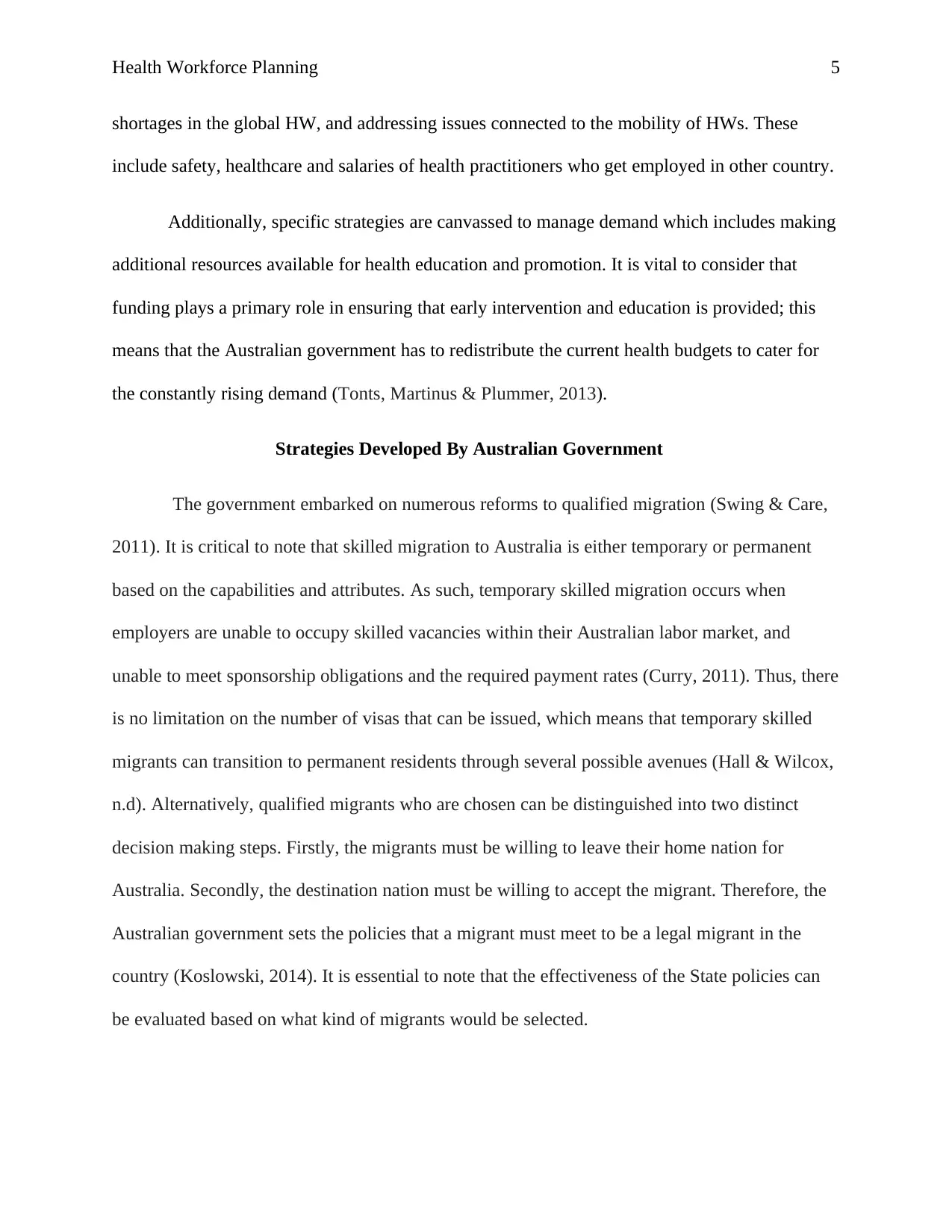
Health Workforce Planning 5
shortages in the global HW, and addressing issues connected to the mobility of HWs. These
include safety, healthcare and salaries of health practitioners who get employed in other country.
Additionally, specific strategies are canvassed to manage demand which includes making
additional resources available for health education and promotion. It is vital to consider that
funding plays a primary role in ensuring that early intervention and education is provided; this
means that the Australian government has to redistribute the current health budgets to cater for
the constantly rising demand (Tonts, Martinus & Plummer, 2013).
Strategies Developed By Australian Government
The government embarked on numerous reforms to qualified migration (Swing & Care,
2011). It is critical to note that skilled migration to Australia is either temporary or permanent
based on the capabilities and attributes. As such, temporary skilled migration occurs when
employers are unable to occupy skilled vacancies within their Australian labor market, and
unable to meet sponsorship obligations and the required payment rates (Curry, 2011). Thus, there
is no limitation on the number of visas that can be issued, which means that temporary skilled
migrants can transition to permanent residents through several possible avenues (Hall & Wilcox,
n.d). Alternatively, qualified migrants who are chosen can be distinguished into two distinct
decision making steps. Firstly, the migrants must be willing to leave their home nation for
Australia. Secondly, the destination nation must be willing to accept the migrant. Therefore, the
Australian government sets the policies that a migrant must meet to be a legal migrant in the
country (Koslowski, 2014). It is essential to note that the effectiveness of the State policies can
be evaluated based on what kind of migrants would be selected.
shortages in the global HW, and addressing issues connected to the mobility of HWs. These
include safety, healthcare and salaries of health practitioners who get employed in other country.
Additionally, specific strategies are canvassed to manage demand which includes making
additional resources available for health education and promotion. It is vital to consider that
funding plays a primary role in ensuring that early intervention and education is provided; this
means that the Australian government has to redistribute the current health budgets to cater for
the constantly rising demand (Tonts, Martinus & Plummer, 2013).
Strategies Developed By Australian Government
The government embarked on numerous reforms to qualified migration (Swing & Care,
2011). It is critical to note that skilled migration to Australia is either temporary or permanent
based on the capabilities and attributes. As such, temporary skilled migration occurs when
employers are unable to occupy skilled vacancies within their Australian labor market, and
unable to meet sponsorship obligations and the required payment rates (Curry, 2011). Thus, there
is no limitation on the number of visas that can be issued, which means that temporary skilled
migrants can transition to permanent residents through several possible avenues (Hall & Wilcox,
n.d). Alternatively, qualified migrants who are chosen can be distinguished into two distinct
decision making steps. Firstly, the migrants must be willing to leave their home nation for
Australia. Secondly, the destination nation must be willing to accept the migrant. Therefore, the
Australian government sets the policies that a migrant must meet to be a legal migrant in the
country (Koslowski, 2014). It is essential to note that the effectiveness of the State policies can
be evaluated based on what kind of migrants would be selected.
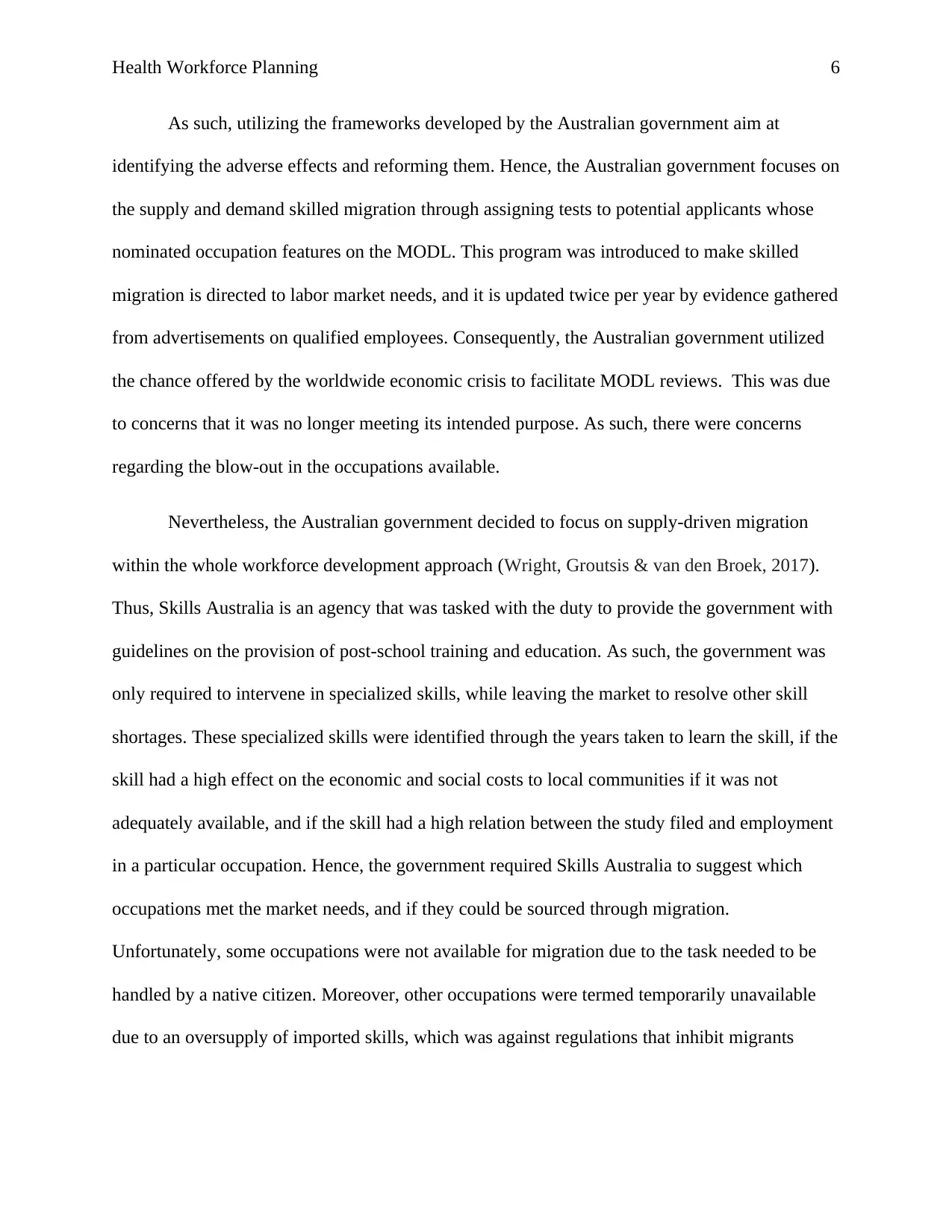
Health Workforce Planning 6
As such, utilizing the frameworks developed by the Australian government aim at
identifying the adverse effects and reforming them. Hence, the Australian government focuses on
the supply and demand skilled migration through assigning tests to potential applicants whose
nominated occupation features on the MODL. This program was introduced to make skilled
migration is directed to labor market needs, and it is updated twice per year by evidence gathered
from advertisements on qualified employees. Consequently, the Australian government utilized
the chance offered by the worldwide economic crisis to facilitate MODL reviews. This was due
to concerns that it was no longer meeting its intended purpose. As such, there were concerns
regarding the blow-out in the occupations available.
Nevertheless, the Australian government decided to focus on supply-driven migration
within the whole workforce development approach (Wright, Groutsis & van den Broek, 2017).
Thus, Skills Australia is an agency that was tasked with the duty to provide the government with
guidelines on the provision of post-school training and education. As such, the government was
only required to intervene in specialized skills, while leaving the market to resolve other skill
shortages. These specialized skills were identified through the years taken to learn the skill, if the
skill had a high effect on the economic and social costs to local communities if it was not
adequately available, and if the skill had a high relation between the study filed and employment
in a particular occupation. Hence, the government required Skills Australia to suggest which
occupations met the market needs, and if they could be sourced through migration.
Unfortunately, some occupations were not available for migration due to the task needed to be
handled by a native citizen. Moreover, other occupations were termed temporarily unavailable
due to an oversupply of imported skills, which was against regulations that inhibit migrants
As such, utilizing the frameworks developed by the Australian government aim at
identifying the adverse effects and reforming them. Hence, the Australian government focuses on
the supply and demand skilled migration through assigning tests to potential applicants whose
nominated occupation features on the MODL. This program was introduced to make skilled
migration is directed to labor market needs, and it is updated twice per year by evidence gathered
from advertisements on qualified employees. Consequently, the Australian government utilized
the chance offered by the worldwide economic crisis to facilitate MODL reviews. This was due
to concerns that it was no longer meeting its intended purpose. As such, there were concerns
regarding the blow-out in the occupations available.
Nevertheless, the Australian government decided to focus on supply-driven migration
within the whole workforce development approach (Wright, Groutsis & van den Broek, 2017).
Thus, Skills Australia is an agency that was tasked with the duty to provide the government with
guidelines on the provision of post-school training and education. As such, the government was
only required to intervene in specialized skills, while leaving the market to resolve other skill
shortages. These specialized skills were identified through the years taken to learn the skill, if the
skill had a high effect on the economic and social costs to local communities if it was not
adequately available, and if the skill had a high relation between the study filed and employment
in a particular occupation. Hence, the government required Skills Australia to suggest which
occupations met the market needs, and if they could be sourced through migration.
Unfortunately, some occupations were not available for migration due to the task needed to be
handled by a native citizen. Moreover, other occupations were termed temporarily unavailable
due to an oversupply of imported skills, which was against regulations that inhibit migrants
⊘ This is a preview!⊘
Do you want full access?
Subscribe today to unlock all pages.

Trusted by 1+ million students worldwide
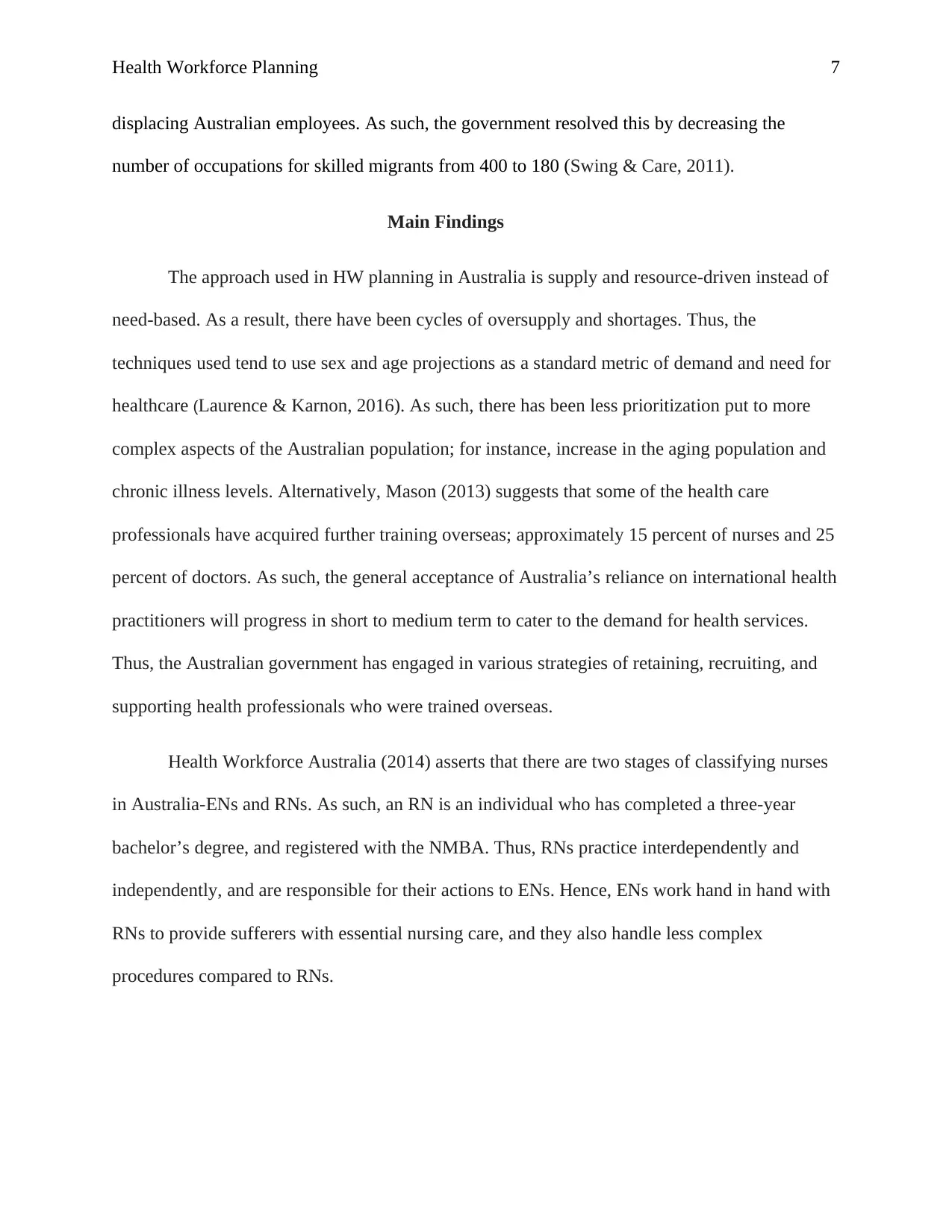
Health Workforce Planning 7
displacing Australian employees. As such, the government resolved this by decreasing the
number of occupations for skilled migrants from 400 to 180 (Swing & Care, 2011).
Main Findings
The approach used in HW planning in Australia is supply and resource-driven instead of
need-based. As a result, there have been cycles of oversupply and shortages. Thus, the
techniques used tend to use sex and age projections as a standard metric of demand and need for
healthcare (Laurence & Karnon, 2016). As such, there has been less prioritization put to more
complex aspects of the Australian population; for instance, increase in the aging population and
chronic illness levels. Alternatively, Mason (2013) suggests that some of the health care
professionals have acquired further training overseas; approximately 15 percent of nurses and 25
percent of doctors. As such, the general acceptance of Australia’s reliance on international health
practitioners will progress in short to medium term to cater to the demand for health services.
Thus, the Australian government has engaged in various strategies of retaining, recruiting, and
supporting health professionals who were trained overseas.
Health Workforce Australia (2014) asserts that there are two stages of classifying nurses
in Australia-ENs and RNs. As such, an RN is an individual who has completed a three-year
bachelor’s degree, and registered with the NMBA. Thus, RNs practice interdependently and
independently, and are responsible for their actions to ENs. Hence, ENs work hand in hand with
RNs to provide sufferers with essential nursing care, and they also handle less complex
procedures compared to RNs.
displacing Australian employees. As such, the government resolved this by decreasing the
number of occupations for skilled migrants from 400 to 180 (Swing & Care, 2011).
Main Findings
The approach used in HW planning in Australia is supply and resource-driven instead of
need-based. As a result, there have been cycles of oversupply and shortages. Thus, the
techniques used tend to use sex and age projections as a standard metric of demand and need for
healthcare (Laurence & Karnon, 2016). As such, there has been less prioritization put to more
complex aspects of the Australian population; for instance, increase in the aging population and
chronic illness levels. Alternatively, Mason (2013) suggests that some of the health care
professionals have acquired further training overseas; approximately 15 percent of nurses and 25
percent of doctors. As such, the general acceptance of Australia’s reliance on international health
practitioners will progress in short to medium term to cater to the demand for health services.
Thus, the Australian government has engaged in various strategies of retaining, recruiting, and
supporting health professionals who were trained overseas.
Health Workforce Australia (2014) asserts that there are two stages of classifying nurses
in Australia-ENs and RNs. As such, an RN is an individual who has completed a three-year
bachelor’s degree, and registered with the NMBA. Thus, RNs practice interdependently and
independently, and are responsible for their actions to ENs. Hence, ENs work hand in hand with
RNs to provide sufferers with essential nursing care, and they also handle less complex
procedures compared to RNs.
Paraphrase This Document
Need a fresh take? Get an instant paraphrase of this document with our AI Paraphraser
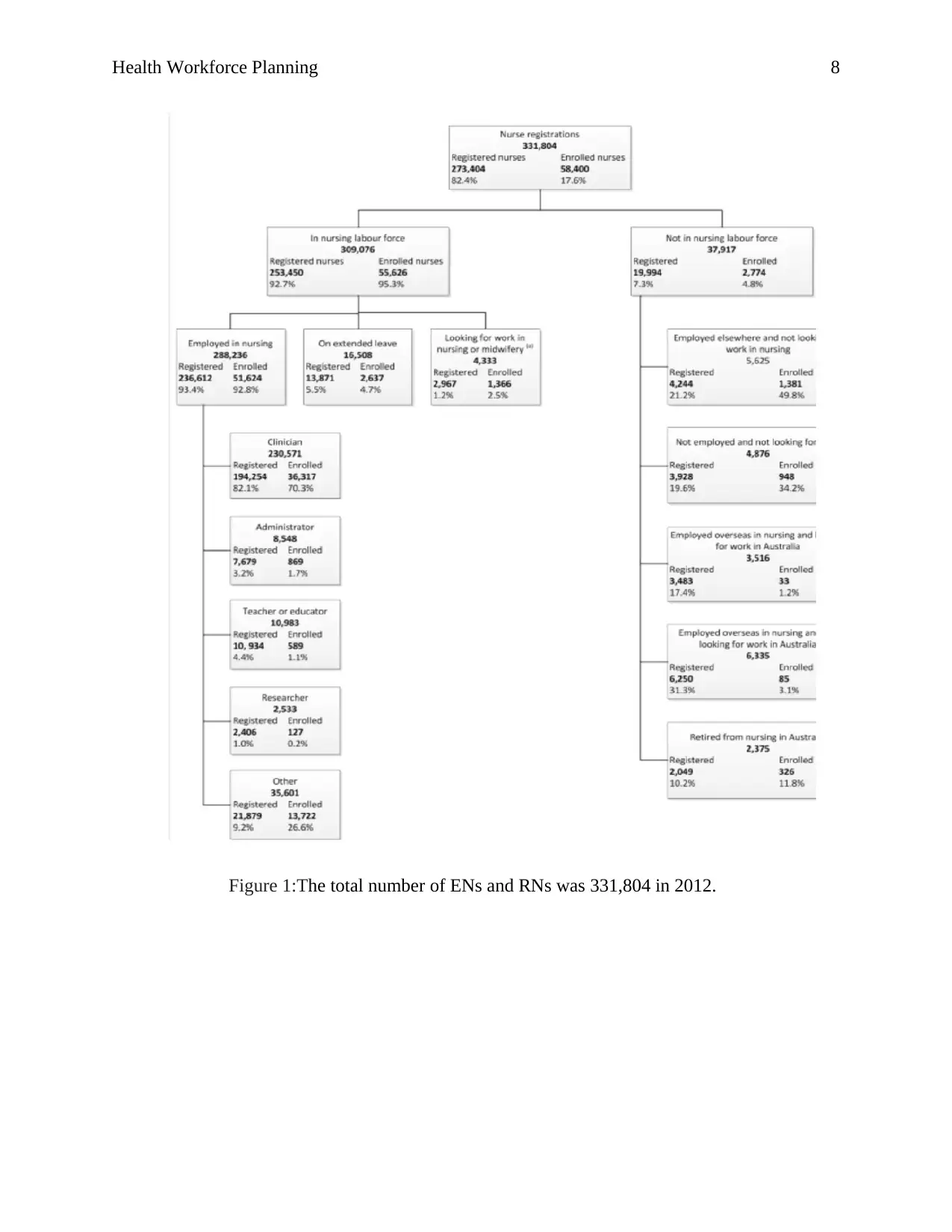
Health Workforce Planning 8
Figure 1:The total number of ENs and RNs was 331,804 in 2012.
Figure 1:The total number of ENs and RNs was 331,804 in 2012.
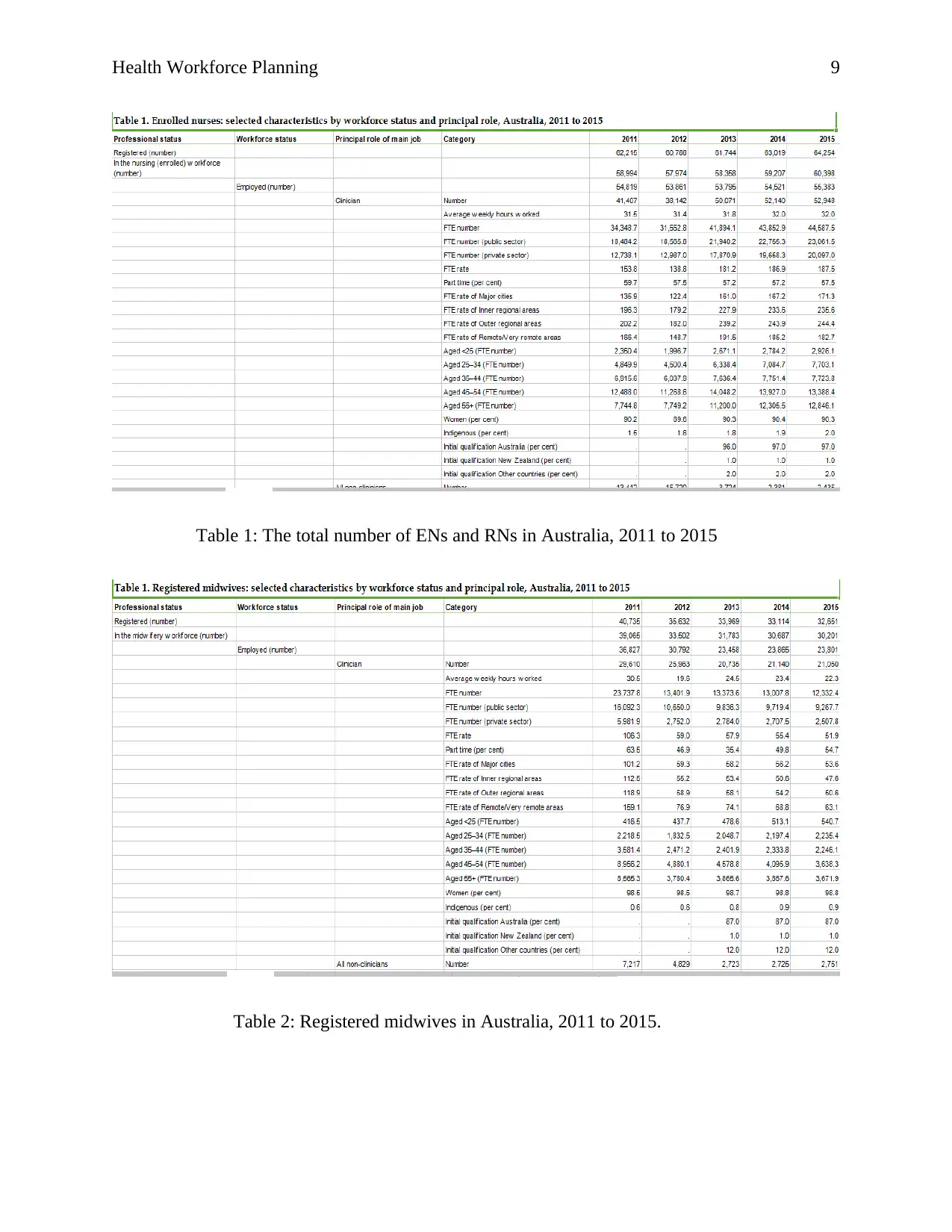
Health Workforce Planning 9
Table 1: The total number of ENs and RNs in Australia, 2011 to 2015
Table 2: Registered midwives in Australia, 2011 to 2015.
Table 1: The total number of ENs and RNs in Australia, 2011 to 2015
Table 2: Registered midwives in Australia, 2011 to 2015.
⊘ This is a preview!⊘
Do you want full access?
Subscribe today to unlock all pages.

Trusted by 1+ million students worldwide
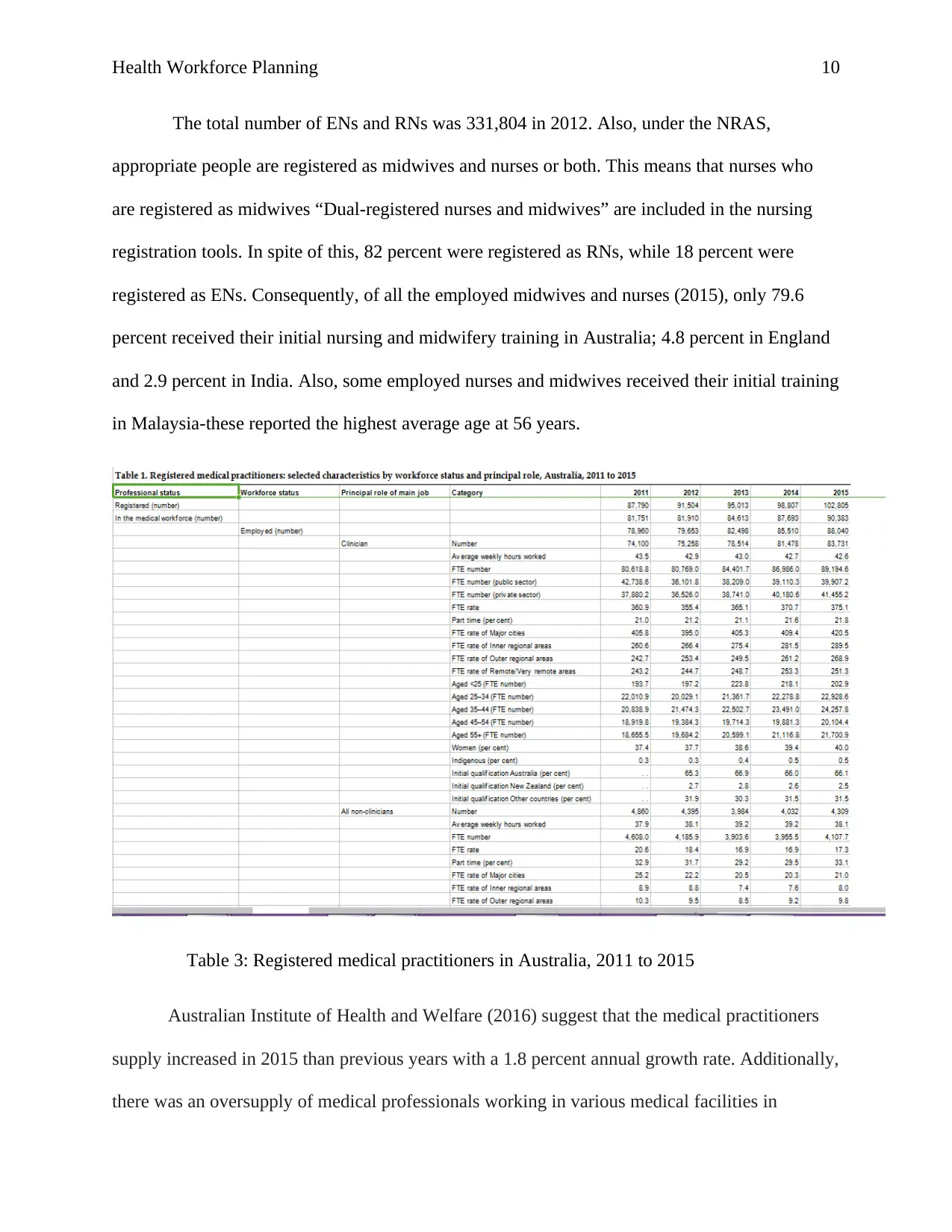
Health Workforce Planning 10
The total number of ENs and RNs was 331,804 in 2012. Also, under the NRAS,
appropriate people are registered as midwives and nurses or both. This means that nurses who
are registered as midwives “Dual-registered nurses and midwives” are included in the nursing
registration tools. In spite of this, 82 percent were registered as RNs, while 18 percent were
registered as ENs. Consequently, of all the employed midwives and nurses (2015), only 79.6
percent received their initial nursing and midwifery training in Australia; 4.8 percent in England
and 2.9 percent in India. Also, some employed nurses and midwives received their initial training
in Malaysia-these reported the highest average age at 56 years.
Table 3: Registered medical practitioners in Australia, 2011 to 2015
Australian Institute of Health and Welfare (2016) suggest that the medical practitioners
supply increased in 2015 than previous years with a 1.8 percent annual growth rate. Additionally,
there was an oversupply of medical professionals working in various medical facilities in
The total number of ENs and RNs was 331,804 in 2012. Also, under the NRAS,
appropriate people are registered as midwives and nurses or both. This means that nurses who
are registered as midwives “Dual-registered nurses and midwives” are included in the nursing
registration tools. In spite of this, 82 percent were registered as RNs, while 18 percent were
registered as ENs. Consequently, of all the employed midwives and nurses (2015), only 79.6
percent received their initial nursing and midwifery training in Australia; 4.8 percent in England
and 2.9 percent in India. Also, some employed nurses and midwives received their initial training
in Malaysia-these reported the highest average age at 56 years.
Table 3: Registered medical practitioners in Australia, 2011 to 2015
Australian Institute of Health and Welfare (2016) suggest that the medical practitioners
supply increased in 2015 than previous years with a 1.8 percent annual growth rate. Additionally,
there was an oversupply of medical professionals working in various medical facilities in
Paraphrase This Document
Need a fresh take? Get an instant paraphrase of this document with our AI Paraphraser
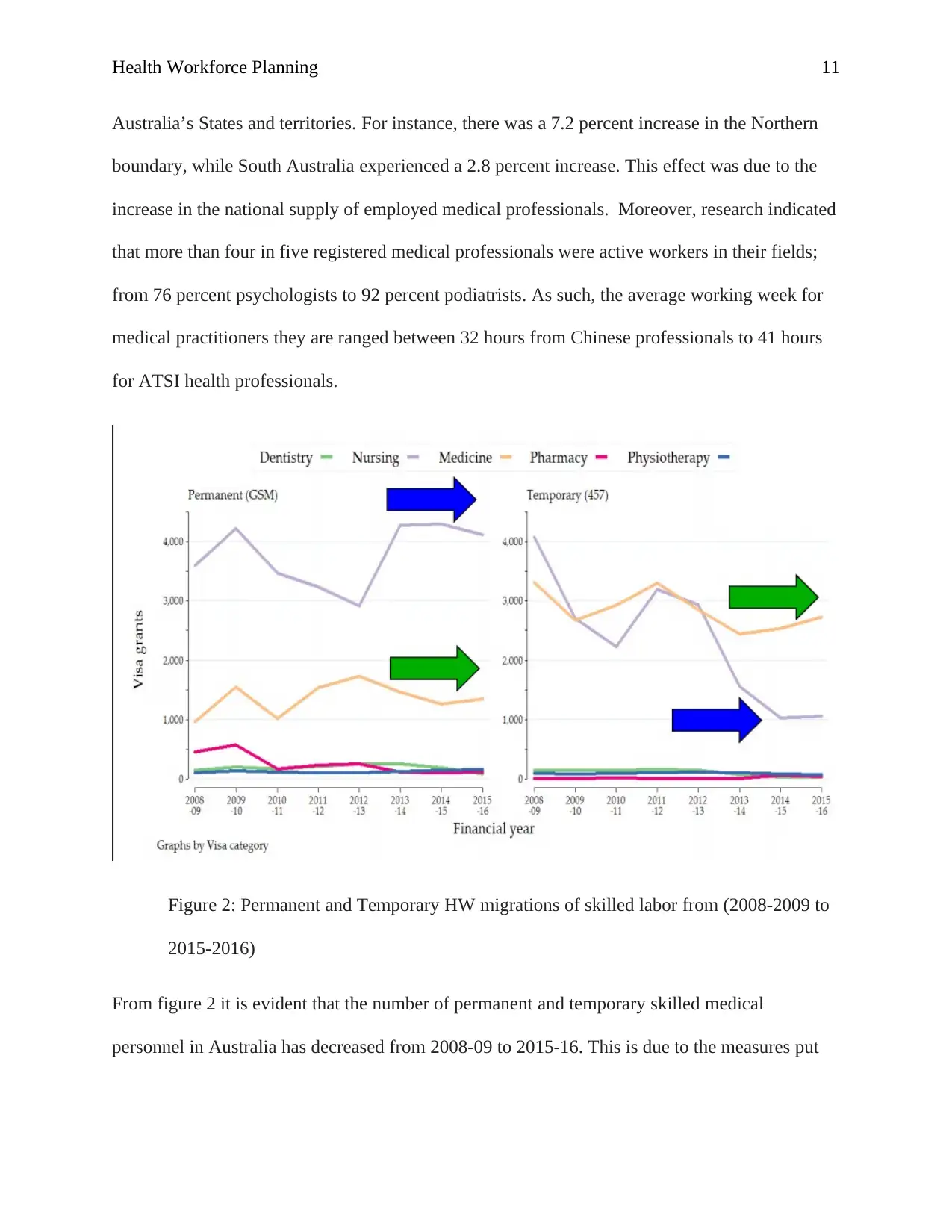
Health Workforce Planning 11
Australia’s States and territories. For instance, there was a 7.2 percent increase in the Northern
boundary, while South Australia experienced a 2.8 percent increase. This effect was due to the
increase in the national supply of employed medical professionals. Moreover, research indicated
that more than four in five registered medical professionals were active workers in their fields;
from 76 percent psychologists to 92 percent podiatrists. As such, the average working week for
medical practitioners they are ranged between 32 hours from Chinese professionals to 41 hours
for ATSI health professionals.
Figure 2: Permanent and Temporary HW migrations of skilled labor from (2008-2009 to
2015-2016)
From figure 2 it is evident that the number of permanent and temporary skilled medical
personnel in Australia has decreased from 2008-09 to 2015-16. This is due to the measures put
Australia’s States and territories. For instance, there was a 7.2 percent increase in the Northern
boundary, while South Australia experienced a 2.8 percent increase. This effect was due to the
increase in the national supply of employed medical professionals. Moreover, research indicated
that more than four in five registered medical professionals were active workers in their fields;
from 76 percent psychologists to 92 percent podiatrists. As such, the average working week for
medical practitioners they are ranged between 32 hours from Chinese professionals to 41 hours
for ATSI health professionals.
Figure 2: Permanent and Temporary HW migrations of skilled labor from (2008-2009 to
2015-2016)
From figure 2 it is evident that the number of permanent and temporary skilled medical
personnel in Australia has decreased from 2008-09 to 2015-16. This is due to the measures put
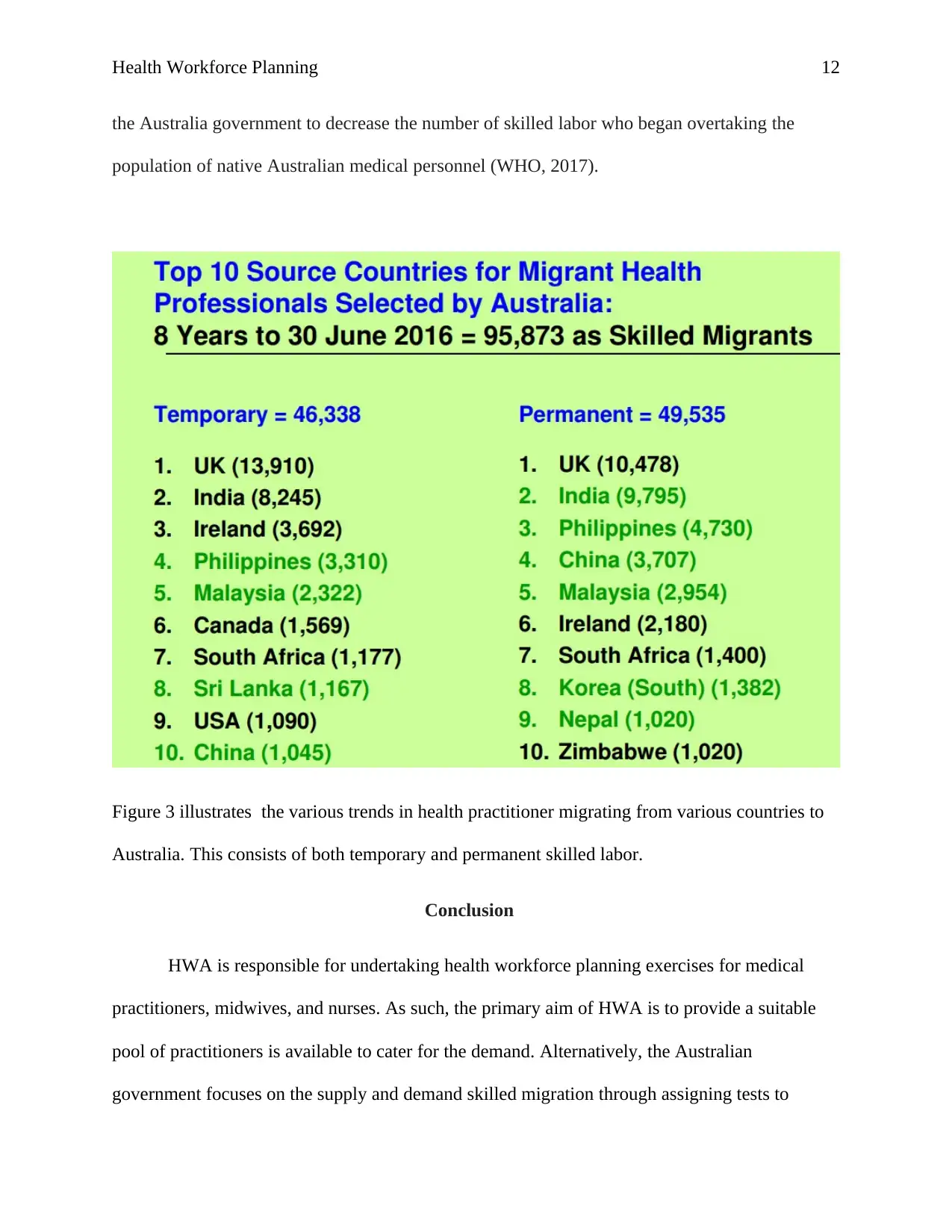
Health Workforce Planning 12
the Australia government to decrease the number of skilled labor who began overtaking the
population of native Australian medical personnel (WHO, 2017).
Figure 3 illustrates the various trends in health practitioner migrating from various countries to
Australia. This consists of both temporary and permanent skilled labor.
Conclusion
HWA is responsible for undertaking health workforce planning exercises for medical
practitioners, midwives, and nurses. As such, the primary aim of HWA is to provide a suitable
pool of practitioners is available to cater for the demand. Alternatively, the Australian
government focuses on the supply and demand skilled migration through assigning tests to
the Australia government to decrease the number of skilled labor who began overtaking the
population of native Australian medical personnel (WHO, 2017).
Figure 3 illustrates the various trends in health practitioner migrating from various countries to
Australia. This consists of both temporary and permanent skilled labor.
Conclusion
HWA is responsible for undertaking health workforce planning exercises for medical
practitioners, midwives, and nurses. As such, the primary aim of HWA is to provide a suitable
pool of practitioners is available to cater for the demand. Alternatively, the Australian
government focuses on the supply and demand skilled migration through assigning tests to
⊘ This is a preview!⊘
Do you want full access?
Subscribe today to unlock all pages.

Trusted by 1+ million students worldwide
1 out of 16
Related Documents
Your All-in-One AI-Powered Toolkit for Academic Success.
+13062052269
info@desklib.com
Available 24*7 on WhatsApp / Email
![[object Object]](/_next/static/media/star-bottom.7253800d.svg)
Unlock your academic potential
Copyright © 2020–2025 A2Z Services. All Rights Reserved. Developed and managed by ZUCOL.





